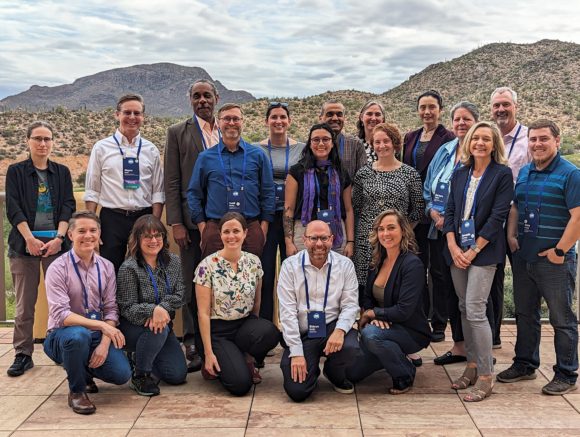In September 2023, City Parks Alliance launched a new initiative to help parks and water practitioners better collaborate on green stormwater infrastructure (GSI) in park systems in ways that can provide access to new green spaces and recreation, enhance climate resilience and protect biodiversity, improve public health and social equity, and provide fiscal benefits.
Working with the US Water Alliance and the Green Infrastructure Leadership Exchange, and with the support of the Robert Wood Johnson Foundation, we invited a cohort of parks and water agency leaders from eight cities to inform how to increase collaboration between these two sectors and address historic inequities. The cohort will share experiences and ideas about successes and overcoming barriers to broader collaboration on developing GSI in urban parks and how to harness the myriad benefits it can bring.

GSI basin with native trees and shrubs at CSM Martin R. “Gunny” Barreras Memorial Park, Tucson, AZ
Over the next two years, we will highlight successful examples of GSI projects in urban parklands, with the hope of inspiring the creation of even more multi-benefit projects. We will also identify and address systemic barriers to better collaboration between parks and water agencies and their partners and share tools, resources, principals, and promising practices to unlock the suite of benefits GSI in parks can provide, all informed by practitioner experience.

Madison Valley Stormwater Storage Facility, Seattle, WA
Our Cohort
The Parks and Green Stormwater Infrastructure Initiative cohort includes Atlanta, Boston, Houston, Milwaukee, Pittsburgh, Raleigh, Seattle, and Tucson. Our members represent the following agencies and organizations:
- Atlanta Department of Watershed Management
- Boston Office of Green Infrastructure
- Boston Parks and Recreation Department
- Harris County (TX) Flood Control District
- Houston Department of Public Works
- Houston Parks Board
- Willow Waterhole Greenspace Conservancy (Houston, TX)
- Milwaukee Metropolitan Sewerage District
- Pittsburgh Water and Sewer Authority
- Pittsburgh Department of City Planning

- Raleigh Stormwater
- Raleigh Parks, Recreation, and Cultural Resources Department
- Seattle Public Utilities
- Seattle Parks and Recreation
- Tucson Water
- Tucson Parks and Recreation Department


About GSI
Resources
Learn From Our Cohort
- Solving Multiple Policy Goals with Green Stormwater Infrastructure in Parks – Greater & Greener presentation featuring Atlanta, Boston, Pittsburgh & Seattle (June 2024)
- Stormwater & Parks: A Deluge of Benefits – One Water Summit presentation featuring Raleigh & Tucson (November 2023)
- Parks and Green Stormwater Infrastructure Initiative Cohort Survey Results (November 2023)
- Effective Cross-Agency Collaboration on Green Infrastructure – City Parks Alliance Webinar (2021)
Additional Resources
- Green Infrastructure in Parks: A Guide to Collaboration, Funding, and Community Engagement – U.S. Environmental Protection Agency (2017)
- Resource Guide For Planning, Designing and Implementing Green Infrastructure in Parks – National Recreation and Park Association (2017)
Our Partners


Support is provided by the Robert Wood Johnson Foundation. The views expressed here do not necessarily reflect the views of the Foundation.

